Analysis of Innovation and Entrepreneurship at Coffee for Delight
VerifiedAdded on 2023/06/04
|8
|1938
|228
Report
AI Summary
This report provides a comprehensive analysis of innovation and entrepreneurship within the context of Coffee for Delight. It begins with an introduction highlighting the crucial role of innovation in business development, emphasizing the need for strategic planning and operational efficiency. The main body delves into the importance of contextual analysis for developing strategic plans, including micro and macro environmental assessments. It explores the significance of creativity, resource allocation, and a change-embracing mindset for fostering innovation and entrepreneurship. The report then presents a SWOT analysis of Coffee for Delight, identifying strengths, weaknesses, opportunities, and threats. It also discusses how to generate new entrepreneurs within the Enterprise. The McKinsey's Three Horizon Model is used to guide business owners in maintaining useful data and managing them according to entrepreneurial principles. The report concludes by emphasizing the importance of intrapreneurship as a means of promoting entrepreneurship within an organization and the strategic framework for corporate Innovation and entrepreneurship.
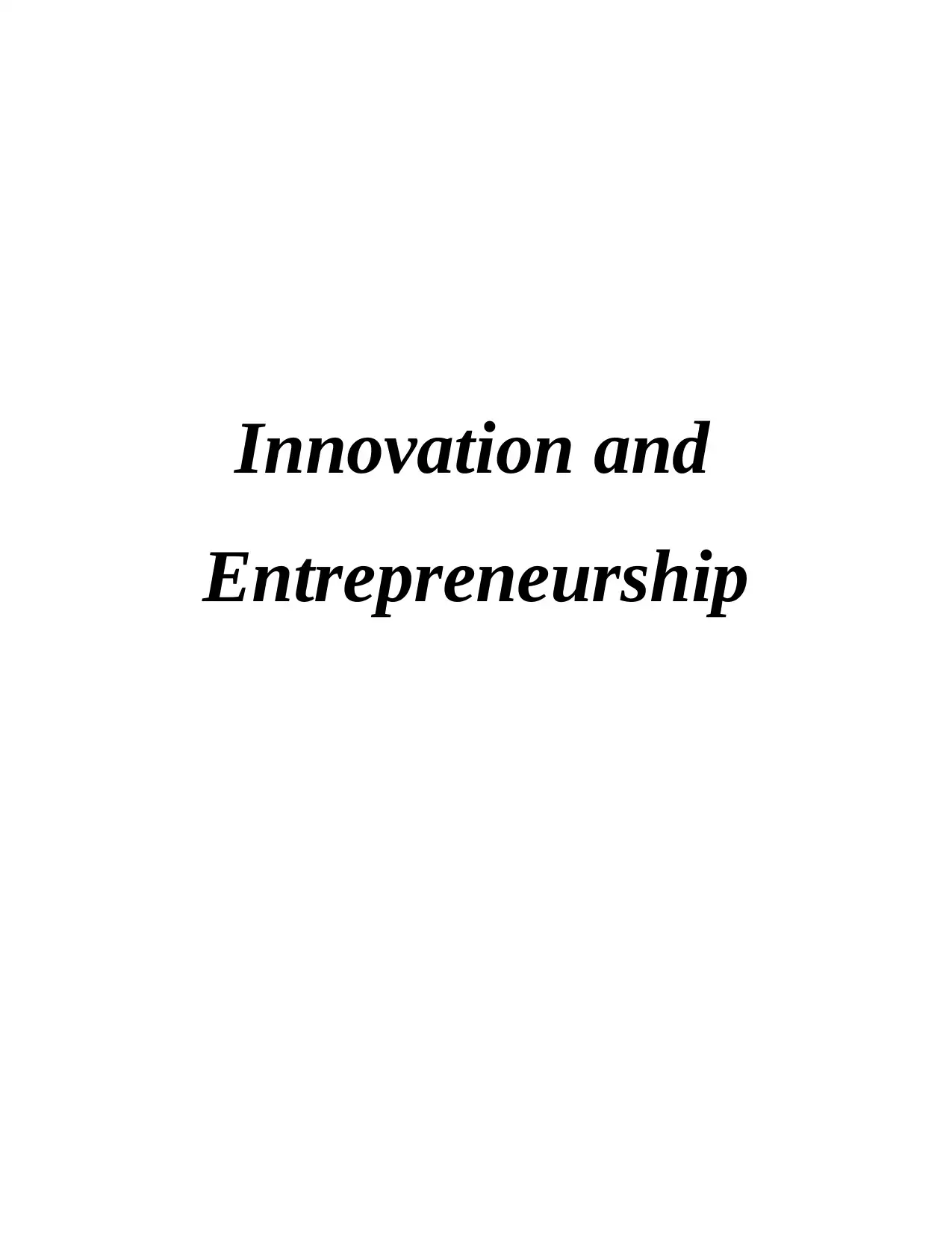
Innovation and
Entrepreneurship
Entrepreneurship
Paraphrase This Document
Need a fresh take? Get an instant paraphrase of this document with our AI Paraphraser

Table of Contents
INTRODUCTION...........................................................................................................................1
MAIN BODY...................................................................................................................................1
CONCLUSION................................................................................................................................4
REFERENCES................................................................................................................................6
INTRODUCTION...........................................................................................................................1
MAIN BODY...................................................................................................................................1
CONCLUSION................................................................................................................................4
REFERENCES................................................................................................................................6
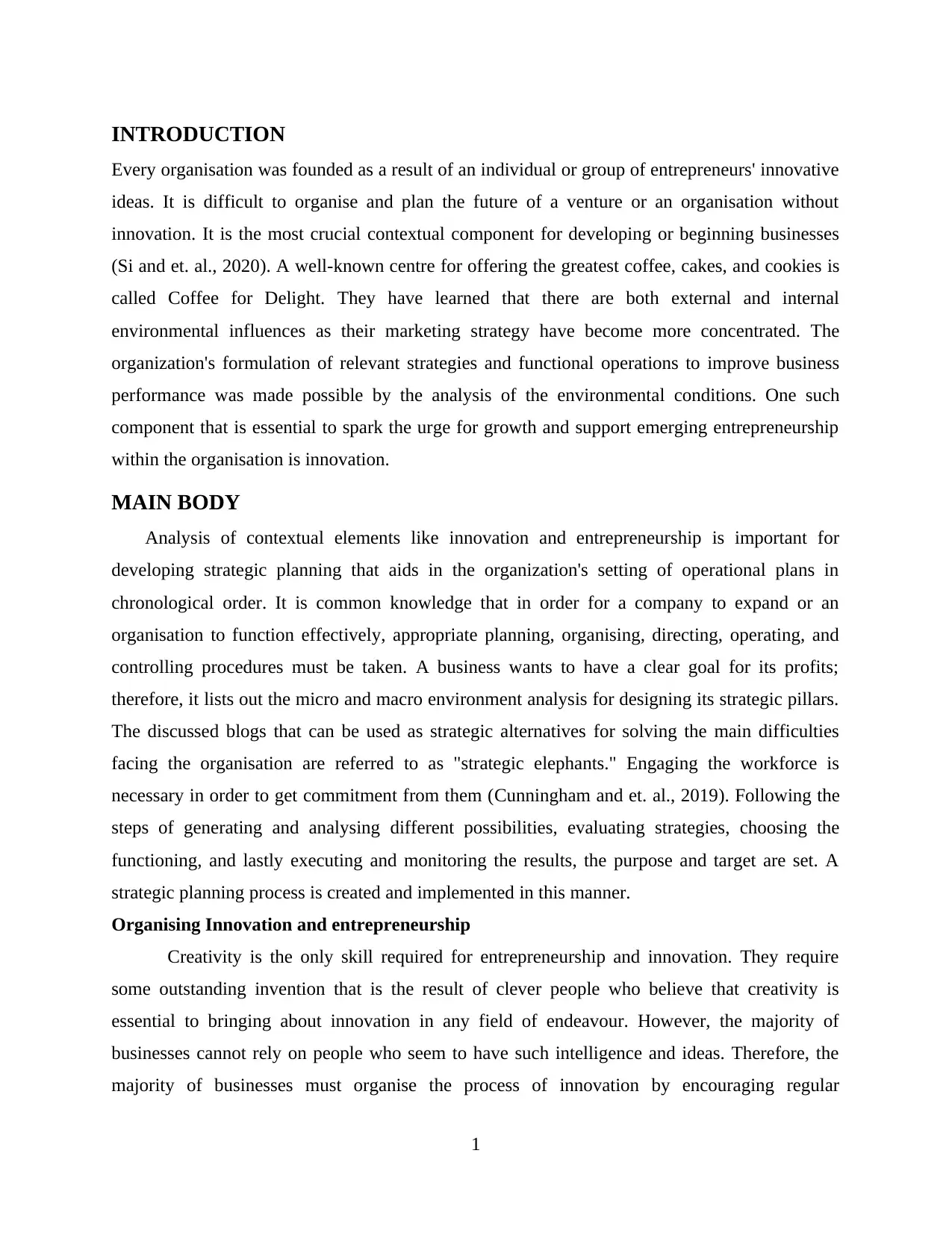
INTRODUCTION
Every organisation was founded as a result of an individual or group of entrepreneurs' innovative
ideas. It is difficult to organise and plan the future of a venture or an organisation without
innovation. It is the most crucial contextual component for developing or beginning businesses
(Si and et. al., 2020). A well-known centre for offering the greatest coffee, cakes, and cookies is
called Coffee for Delight. They have learned that there are both external and internal
environmental influences as their marketing strategy have become more concentrated. The
organization's formulation of relevant strategies and functional operations to improve business
performance was made possible by the analysis of the environmental conditions. One such
component that is essential to spark the urge for growth and support emerging entrepreneurship
within the organisation is innovation.
MAIN BODY
Analysis of contextual elements like innovation and entrepreneurship is important for
developing strategic planning that aids in the organization's setting of operational plans in
chronological order. It is common knowledge that in order for a company to expand or an
organisation to function effectively, appropriate planning, organising, directing, operating, and
controlling procedures must be taken. A business wants to have a clear goal for its profits;
therefore, it lists out the micro and macro environment analysis for designing its strategic pillars.
The discussed blogs that can be used as strategic alternatives for solving the main difficulties
facing the organisation are referred to as "strategic elephants." Engaging the workforce is
necessary in order to get commitment from them (Cunningham and et. al., 2019). Following the
steps of generating and analysing different possibilities, evaluating strategies, choosing the
functioning, and lastly executing and monitoring the results, the purpose and target are set. A
strategic planning process is created and implemented in this manner.
Organising Innovation and entrepreneurship
Creativity is the only skill required for entrepreneurship and innovation. They require
some outstanding invention that is the result of clever people who believe that creativity is
essential to bringing about innovation in any field of endeavour. However, the majority of
businesses cannot rely on people who seem to have such intelligence and ideas. Therefore, the
majority of businesses must organise the process of innovation by encouraging regular
1
Every organisation was founded as a result of an individual or group of entrepreneurs' innovative
ideas. It is difficult to organise and plan the future of a venture or an organisation without
innovation. It is the most crucial contextual component for developing or beginning businesses
(Si and et. al., 2020). A well-known centre for offering the greatest coffee, cakes, and cookies is
called Coffee for Delight. They have learned that there are both external and internal
environmental influences as their marketing strategy have become more concentrated. The
organization's formulation of relevant strategies and functional operations to improve business
performance was made possible by the analysis of the environmental conditions. One such
component that is essential to spark the urge for growth and support emerging entrepreneurship
within the organisation is innovation.
MAIN BODY
Analysis of contextual elements like innovation and entrepreneurship is important for
developing strategic planning that aids in the organization's setting of operational plans in
chronological order. It is common knowledge that in order for a company to expand or an
organisation to function effectively, appropriate planning, organising, directing, operating, and
controlling procedures must be taken. A business wants to have a clear goal for its profits;
therefore, it lists out the micro and macro environment analysis for designing its strategic pillars.
The discussed blogs that can be used as strategic alternatives for solving the main difficulties
facing the organisation are referred to as "strategic elephants." Engaging the workforce is
necessary in order to get commitment from them (Cunningham and et. al., 2019). Following the
steps of generating and analysing different possibilities, evaluating strategies, choosing the
functioning, and lastly executing and monitoring the results, the purpose and target are set. A
strategic planning process is created and implemented in this manner.
Organising Innovation and entrepreneurship
Creativity is the only skill required for entrepreneurship and innovation. They require
some outstanding invention that is the result of clever people who believe that creativity is
essential to bringing about innovation in any field of endeavour. However, the majority of
businesses cannot rely on people who seem to have such intelligence and ideas. Therefore, the
majority of businesses must organise the process of innovation by encouraging regular
1
⊘ This is a preview!⊘
Do you want full access?
Subscribe today to unlock all pages.

Trusted by 1+ million students worldwide
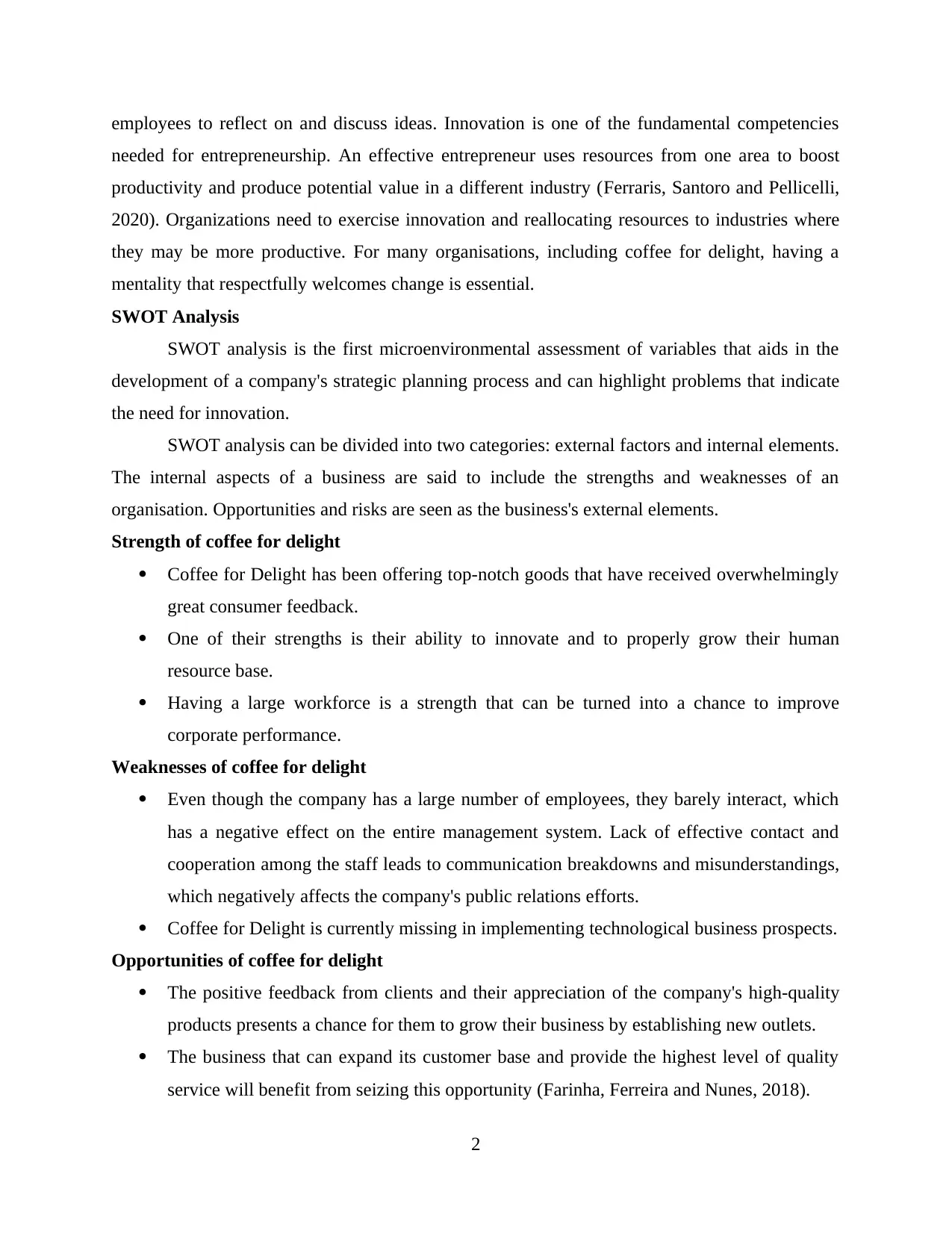
employees to reflect on and discuss ideas. Innovation is one of the fundamental competencies
needed for entrepreneurship. An effective entrepreneur uses resources from one area to boost
productivity and produce potential value in a different industry (Ferraris, Santoro and Pellicelli,
2020). Organizations need to exercise innovation and reallocating resources to industries where
they may be more productive. For many organisations, including coffee for delight, having a
mentality that respectfully welcomes change is essential.
SWOT Analysis
SWOT analysis is the first microenvironmental assessment of variables that aids in the
development of a company's strategic planning process and can highlight problems that indicate
the need for innovation.
SWOT analysis can be divided into two categories: external factors and internal elements.
The internal aspects of a business are said to include the strengths and weaknesses of an
organisation. Opportunities and risks are seen as the business's external elements.
Strength of coffee for delight
Coffee for Delight has been offering top-notch goods that have received overwhelmingly
great consumer feedback.
One of their strengths is their ability to innovate and to properly grow their human
resource base.
Having a large workforce is a strength that can be turned into a chance to improve
corporate performance.
Weaknesses of coffee for delight
Even though the company has a large number of employees, they barely interact, which
has a negative effect on the entire management system. Lack of effective contact and
cooperation among the staff leads to communication breakdowns and misunderstandings,
which negatively affects the company's public relations efforts.
Coffee for Delight is currently missing in implementing technological business prospects.
Opportunities of coffee for delight
The positive feedback from clients and their appreciation of the company's high-quality
products presents a chance for them to grow their business by establishing new outlets.
The business that can expand its customer base and provide the highest level of quality
service will benefit from seizing this opportunity (Farinha, Ferreira and Nunes, 2018).
2
needed for entrepreneurship. An effective entrepreneur uses resources from one area to boost
productivity and produce potential value in a different industry (Ferraris, Santoro and Pellicelli,
2020). Organizations need to exercise innovation and reallocating resources to industries where
they may be more productive. For many organisations, including coffee for delight, having a
mentality that respectfully welcomes change is essential.
SWOT Analysis
SWOT analysis is the first microenvironmental assessment of variables that aids in the
development of a company's strategic planning process and can highlight problems that indicate
the need for innovation.
SWOT analysis can be divided into two categories: external factors and internal elements.
The internal aspects of a business are said to include the strengths and weaknesses of an
organisation. Opportunities and risks are seen as the business's external elements.
Strength of coffee for delight
Coffee for Delight has been offering top-notch goods that have received overwhelmingly
great consumer feedback.
One of their strengths is their ability to innovate and to properly grow their human
resource base.
Having a large workforce is a strength that can be turned into a chance to improve
corporate performance.
Weaknesses of coffee for delight
Even though the company has a large number of employees, they barely interact, which
has a negative effect on the entire management system. Lack of effective contact and
cooperation among the staff leads to communication breakdowns and misunderstandings,
which negatively affects the company's public relations efforts.
Coffee for Delight is currently missing in implementing technological business prospects.
Opportunities of coffee for delight
The positive feedback from clients and their appreciation of the company's high-quality
products presents a chance for them to grow their business by establishing new outlets.
The business that can expand its customer base and provide the highest level of quality
service will benefit from seizing this opportunity (Farinha, Ferreira and Nunes, 2018).
2
Paraphrase This Document
Need a fresh take? Get an instant paraphrase of this document with our AI Paraphraser
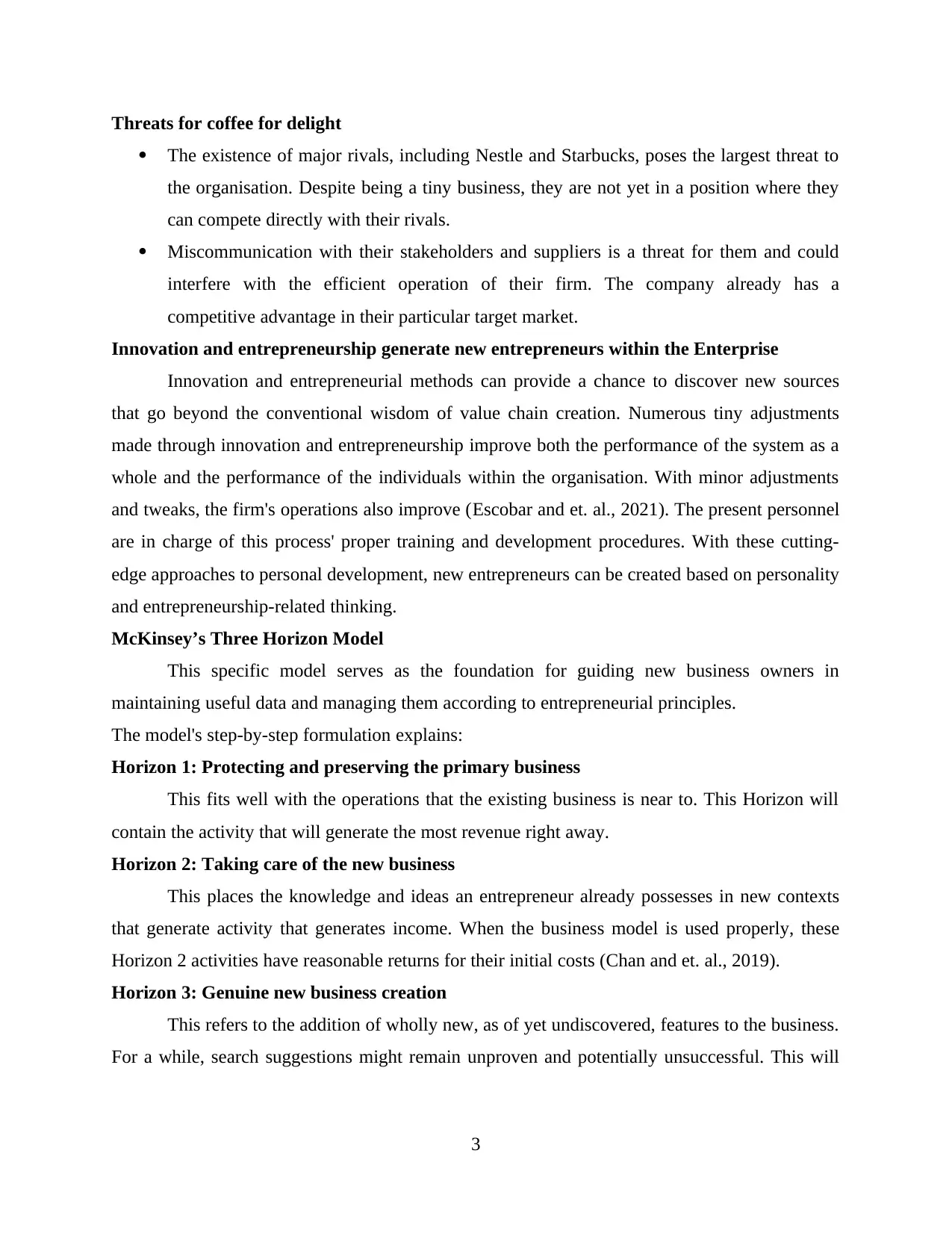
Threats for coffee for delight
The existence of major rivals, including Nestle and Starbucks, poses the largest threat to
the organisation. Despite being a tiny business, they are not yet in a position where they
can compete directly with their rivals.
Miscommunication with their stakeholders and suppliers is a threat for them and could
interfere with the efficient operation of their firm. The company already has a
competitive advantage in their particular target market.
Innovation and entrepreneurship generate new entrepreneurs within the Enterprise
Innovation and entrepreneurial methods can provide a chance to discover new sources
that go beyond the conventional wisdom of value chain creation. Numerous tiny adjustments
made through innovation and entrepreneurship improve both the performance of the system as a
whole and the performance of the individuals within the organisation. With minor adjustments
and tweaks, the firm's operations also improve (Escobar and et. al., 2021). The present personnel
are in charge of this process' proper training and development procedures. With these cutting-
edge approaches to personal development, new entrepreneurs can be created based on personality
and entrepreneurship-related thinking.
McKinsey’s Three Horizon Model
This specific model serves as the foundation for guiding new business owners in
maintaining useful data and managing them according to entrepreneurial principles.
The model's step-by-step formulation explains:
Horizon 1: Protecting and preserving the primary business
This fits well with the operations that the existing business is near to. This Horizon will
contain the activity that will generate the most revenue right away.
Horizon 2: Taking care of the new business
This places the knowledge and ideas an entrepreneur already possesses in new contexts
that generate activity that generates income. When the business model is used properly, these
Horizon 2 activities have reasonable returns for their initial costs (Chan and et. al., 2019).
Horizon 3: Genuine new business creation
This refers to the addition of wholly new, as of yet undiscovered, features to the business.
For a while, search suggestions might remain unproven and potentially unsuccessful. This will
3
The existence of major rivals, including Nestle and Starbucks, poses the largest threat to
the organisation. Despite being a tiny business, they are not yet in a position where they
can compete directly with their rivals.
Miscommunication with their stakeholders and suppliers is a threat for them and could
interfere with the efficient operation of their firm. The company already has a
competitive advantage in their particular target market.
Innovation and entrepreneurship generate new entrepreneurs within the Enterprise
Innovation and entrepreneurial methods can provide a chance to discover new sources
that go beyond the conventional wisdom of value chain creation. Numerous tiny adjustments
made through innovation and entrepreneurship improve both the performance of the system as a
whole and the performance of the individuals within the organisation. With minor adjustments
and tweaks, the firm's operations also improve (Escobar and et. al., 2021). The present personnel
are in charge of this process' proper training and development procedures. With these cutting-
edge approaches to personal development, new entrepreneurs can be created based on personality
and entrepreneurship-related thinking.
McKinsey’s Three Horizon Model
This specific model serves as the foundation for guiding new business owners in
maintaining useful data and managing them according to entrepreneurial principles.
The model's step-by-step formulation explains:
Horizon 1: Protecting and preserving the primary business
This fits well with the operations that the existing business is near to. This Horizon will
contain the activity that will generate the most revenue right away.
Horizon 2: Taking care of the new business
This places the knowledge and ideas an entrepreneur already possesses in new contexts
that generate activity that generates income. When the business model is used properly, these
Horizon 2 activities have reasonable returns for their initial costs (Chan and et. al., 2019).
Horizon 3: Genuine new business creation
This refers to the addition of wholly new, as of yet undiscovered, features to the business.
For a while, search suggestions might remain unproven and potentially unsuccessful. This will
3
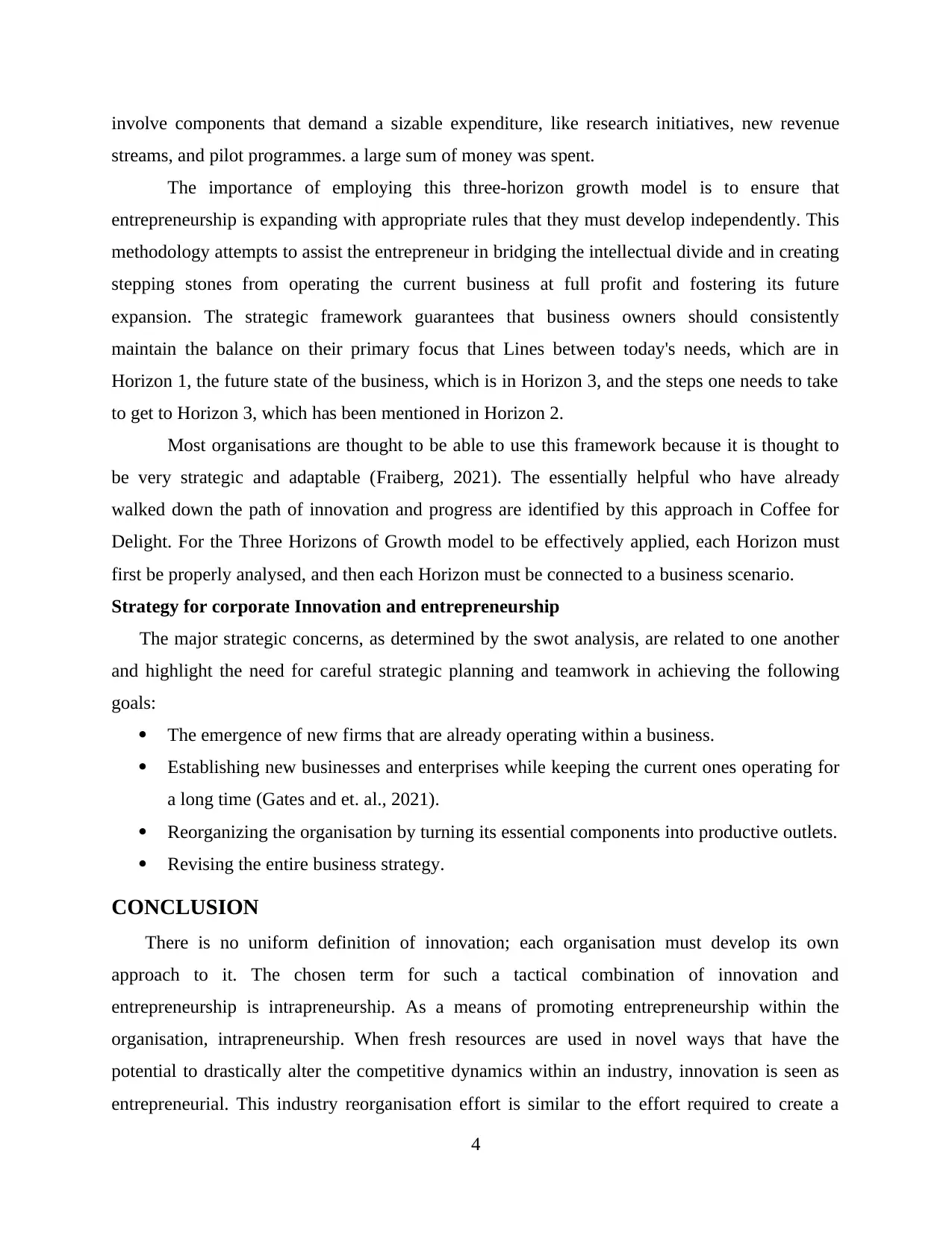
involve components that demand a sizable expenditure, like research initiatives, new revenue
streams, and pilot programmes. a large sum of money was spent.
The importance of employing this three-horizon growth model is to ensure that
entrepreneurship is expanding with appropriate rules that they must develop independently. This
methodology attempts to assist the entrepreneur in bridging the intellectual divide and in creating
stepping stones from operating the current business at full profit and fostering its future
expansion. The strategic framework guarantees that business owners should consistently
maintain the balance on their primary focus that Lines between today's needs, which are in
Horizon 1, the future state of the business, which is in Horizon 3, and the steps one needs to take
to get to Horizon 3, which has been mentioned in Horizon 2.
Most organisations are thought to be able to use this framework because it is thought to
be very strategic and adaptable (Fraiberg, 2021). The essentially helpful who have already
walked down the path of innovation and progress are identified by this approach in Coffee for
Delight. For the Three Horizons of Growth model to be effectively applied, each Horizon must
first be properly analysed, and then each Horizon must be connected to a business scenario.
Strategy for corporate Innovation and entrepreneurship
The major strategic concerns, as determined by the swot analysis, are related to one another
and highlight the need for careful strategic planning and teamwork in achieving the following
goals:
The emergence of new firms that are already operating within a business.
Establishing new businesses and enterprises while keeping the current ones operating for
a long time (Gates and et. al., 2021).
Reorganizing the organisation by turning its essential components into productive outlets.
Revising the entire business strategy.
CONCLUSION
There is no uniform definition of innovation; each organisation must develop its own
approach to it. The chosen term for such a tactical combination of innovation and
entrepreneurship is intrapreneurship. As a means of promoting entrepreneurship within the
organisation, intrapreneurship. When fresh resources are used in novel ways that have the
potential to drastically alter the competitive dynamics within an industry, innovation is seen as
entrepreneurial. This industry reorganisation effort is similar to the effort required to create a
4
streams, and pilot programmes. a large sum of money was spent.
The importance of employing this three-horizon growth model is to ensure that
entrepreneurship is expanding with appropriate rules that they must develop independently. This
methodology attempts to assist the entrepreneur in bridging the intellectual divide and in creating
stepping stones from operating the current business at full profit and fostering its future
expansion. The strategic framework guarantees that business owners should consistently
maintain the balance on their primary focus that Lines between today's needs, which are in
Horizon 1, the future state of the business, which is in Horizon 3, and the steps one needs to take
to get to Horizon 3, which has been mentioned in Horizon 2.
Most organisations are thought to be able to use this framework because it is thought to
be very strategic and adaptable (Fraiberg, 2021). The essentially helpful who have already
walked down the path of innovation and progress are identified by this approach in Coffee for
Delight. For the Three Horizons of Growth model to be effectively applied, each Horizon must
first be properly analysed, and then each Horizon must be connected to a business scenario.
Strategy for corporate Innovation and entrepreneurship
The major strategic concerns, as determined by the swot analysis, are related to one another
and highlight the need for careful strategic planning and teamwork in achieving the following
goals:
The emergence of new firms that are already operating within a business.
Establishing new businesses and enterprises while keeping the current ones operating for
a long time (Gates and et. al., 2021).
Reorganizing the organisation by turning its essential components into productive outlets.
Revising the entire business strategy.
CONCLUSION
There is no uniform definition of innovation; each organisation must develop its own
approach to it. The chosen term for such a tactical combination of innovation and
entrepreneurship is intrapreneurship. As a means of promoting entrepreneurship within the
organisation, intrapreneurship. When fresh resources are used in novel ways that have the
potential to drastically alter the competitive dynamics within an industry, innovation is seen as
entrepreneurial. This industry reorganisation effort is similar to the effort required to create a
4
⊘ This is a preview!⊘
Do you want full access?
Subscribe today to unlock all pages.

Trusted by 1+ million students worldwide

new industry. The majority of businesses struggle to keep up with the significant advances that
frequently bring Apparent comparison to be well endowed for disrupting the issues with the
company. When a business crosses an industrial boundary and enters a different industry,
something can happen.
5
frequently bring Apparent comparison to be well endowed for disrupting the issues with the
company. When a business crosses an industrial boundary and enters a different industry,
something can happen.
5
Paraphrase This Document
Need a fresh take? Get an instant paraphrase of this document with our AI Paraphraser
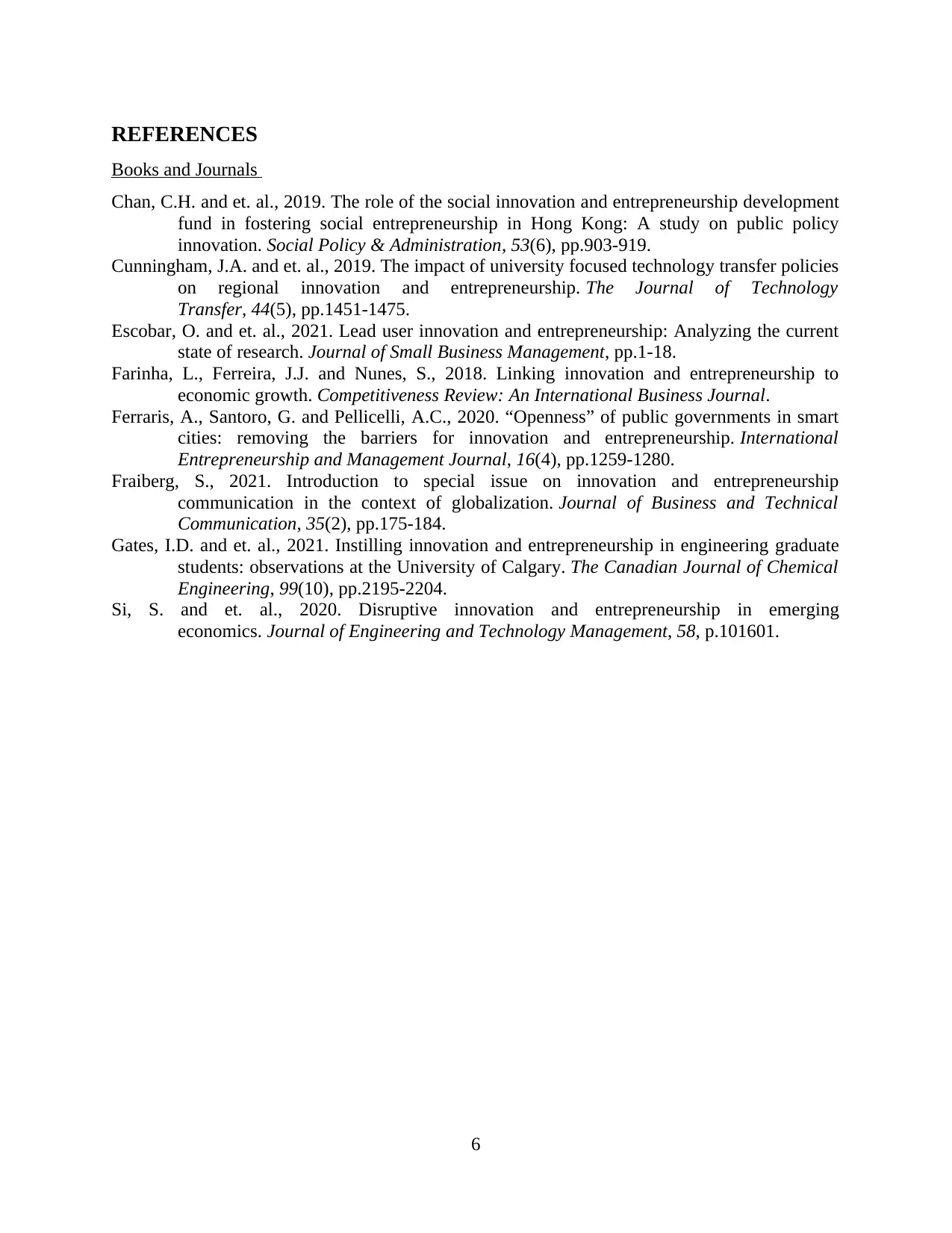
REFERENCES
Books and Journals
Chan, C.H. and et. al., 2019. The role of the social innovation and entrepreneurship development
fund in fostering social entrepreneurship in Hong Kong: A study on public policy
innovation. Social Policy & Administration, 53(6), pp.903-919.
Cunningham, J.A. and et. al., 2019. The impact of university focused technology transfer policies
on regional innovation and entrepreneurship. The Journal of Technology
Transfer, 44(5), pp.1451-1475.
Escobar, O. and et. al., 2021. Lead user innovation and entrepreneurship: Analyzing the current
state of research. Journal of Small Business Management, pp.1-18.
Farinha, L., Ferreira, J.J. and Nunes, S., 2018. Linking innovation and entrepreneurship to
economic growth. Competitiveness Review: An International Business Journal.
Ferraris, A., Santoro, G. and Pellicelli, A.C., 2020. “Openness” of public governments in smart
cities: removing the barriers for innovation and entrepreneurship. International
Entrepreneurship and Management Journal, 16(4), pp.1259-1280.
Fraiberg, S., 2021. Introduction to special issue on innovation and entrepreneurship
communication in the context of globalization. Journal of Business and Technical
Communication, 35(2), pp.175-184.
Gates, I.D. and et. al., 2021. Instilling innovation and entrepreneurship in engineering graduate
students: observations at the University of Calgary. The Canadian Journal of Chemical
Engineering, 99(10), pp.2195-2204.
Si, S. and et. al., 2020. Disruptive innovation and entrepreneurship in emerging
economics. Journal of Engineering and Technology Management, 58, p.101601.
6
Books and Journals
Chan, C.H. and et. al., 2019. The role of the social innovation and entrepreneurship development
fund in fostering social entrepreneurship in Hong Kong: A study on public policy
innovation. Social Policy & Administration, 53(6), pp.903-919.
Cunningham, J.A. and et. al., 2019. The impact of university focused technology transfer policies
on regional innovation and entrepreneurship. The Journal of Technology
Transfer, 44(5), pp.1451-1475.
Escobar, O. and et. al., 2021. Lead user innovation and entrepreneurship: Analyzing the current
state of research. Journal of Small Business Management, pp.1-18.
Farinha, L., Ferreira, J.J. and Nunes, S., 2018. Linking innovation and entrepreneurship to
economic growth. Competitiveness Review: An International Business Journal.
Ferraris, A., Santoro, G. and Pellicelli, A.C., 2020. “Openness” of public governments in smart
cities: removing the barriers for innovation and entrepreneurship. International
Entrepreneurship and Management Journal, 16(4), pp.1259-1280.
Fraiberg, S., 2021. Introduction to special issue on innovation and entrepreneurship
communication in the context of globalization. Journal of Business and Technical
Communication, 35(2), pp.175-184.
Gates, I.D. and et. al., 2021. Instilling innovation and entrepreneurship in engineering graduate
students: observations at the University of Calgary. The Canadian Journal of Chemical
Engineering, 99(10), pp.2195-2204.
Si, S. and et. al., 2020. Disruptive innovation and entrepreneurship in emerging
economics. Journal of Engineering and Technology Management, 58, p.101601.
6
1 out of 8
Related Documents
Your All-in-One AI-Powered Toolkit for Academic Success.
+13062052269
info@desklib.com
Available 24*7 on WhatsApp / Email
![[object Object]](/_next/static/media/star-bottom.7253800d.svg)
Unlock your academic potential
Copyright © 2020–2025 A2Z Services. All Rights Reserved. Developed and managed by ZUCOL.



